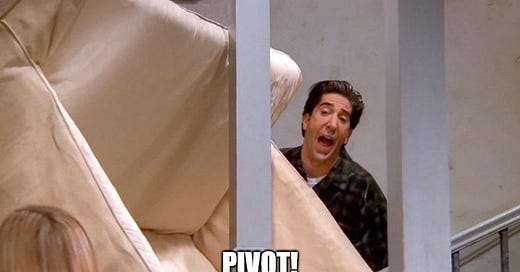Its time to pivot
Last week saw the release of the FOMC meeting minutes from July. FOMC participants were very close to lowering rates in July.
“Participants observed that inflation had eased over the past year but remained elevated and that, in recent months, there had been some further progress toward the Committee's 2 percent inflation objective.”
“With regard to the outlook for inflation, participants judged that recent data had increased their confidence that inflation was moving sustainably toward 2 percent. Almost all participants observed that the factors that had contributed to recent disinflation would likely continue to put downward pressure on inflation in coming months.”
“The vast majority observed that, if the data continued to come in about as expected, it would likely be appropriate to ease policy at the next meeting.”
The risk to the Fed engineering a soft landing has now pivoted to the labor market.
“A majority of participants remarked that the risks to the employment goal had increased, and many participants noted that the risks to the inflation goal had decreased. Some participants noted the risk that a further gradual easing in labor market conditions could transition to a more serious deterioration.”
Jay Powell and company were at the Jackson Hole Symposium put on by the Kansas City Fed. On Friday the 23rd, he gave the following speech:
“The time has come for policy to adjust. The direction of travel is clear, and the timing and pace of rate cuts will depend on incoming data, the evolving outlook, and the balance of risks.”
There are many things that have to go right for the Fed to engineer a soft landing. The goal of the soft landing is to keep interest rates high enough to arrest inflation but not so high as to cause a severe downturn in the economy.
There are nine instances where inflation peaked above 5% and the Fed attempted to slowdown inflation without creating a recession; 1965, 1970, 1974, 1980, 1984, 1990, 1994-95, 2008, 2020-current. In only 3 of these instances was a soft landing achieved (1965, 1994-95, and 1984). This gives us raw odds of a soft landing at 37.5% (3 out of 8). As any pilot will attest, every landing is different. To get this landing right requires more than just the Fed changing monetary policy.
The US Treasury has a role to play in all this and to-date they have not been on board with the rate hikes coming from the Fed. By flooding the market with short-dated treasuries and running an operation twist (where longer-dated treasuries are bought-back with shorter-term issued debt) the Treasury has successfully hampered the yield curve, increased the Fed-Gov’s interest expense, and resisted a normalization process that would have cleansed the market of mal-investment. With any luck, Janet Yellen’s tenure as Treasury Secretary will soon be coming to an end.
Also weighing on the soft-landing is geopolitics and other central banks. With wars in both eastern Europe and the middle-east, unexpected outcomes could quickly derail the Fed’s attempt. In addition, policy changes coming out of Japan look to add a new challenge. As Japan works towards normalizing their central bank policy and raising interest rates, the continued unwind of the yen-carry trade will weight on markets.
The final two components to getting this right include the election and luck. Getting an administration into power that is willing to end deficit spending will go a long way in helping the Fed navigate this landing. Deficit spending has proven to be highly inflationary without the counterweight of globalization. It could give rise to a second inflationary wave. In addition, we need an administration that can accurately keep track of statistics. The disaster that is the BLS needs a house cleaning after the performance art that was the last 14 months’ worth of job reports. A roughly 1.2 million jobs adjustment clouds the judgement of those who rely on those statistics to accurately forecast the economy.
A helping of luck would also aid the effort. Monetary policy takes time to work through the economy and therefore, works with a lag. The Fed must determine the pace of cuts without the benefit of seeing the full effect of the prior hikes or cuts.
If the Fed cuts too much or too soon, inflation can come roaring back. If too slow, spending could dry up, unemployment could spike, and a real economic slowdown could happen. It will take a steady hand and a lot of help to get this just right.





